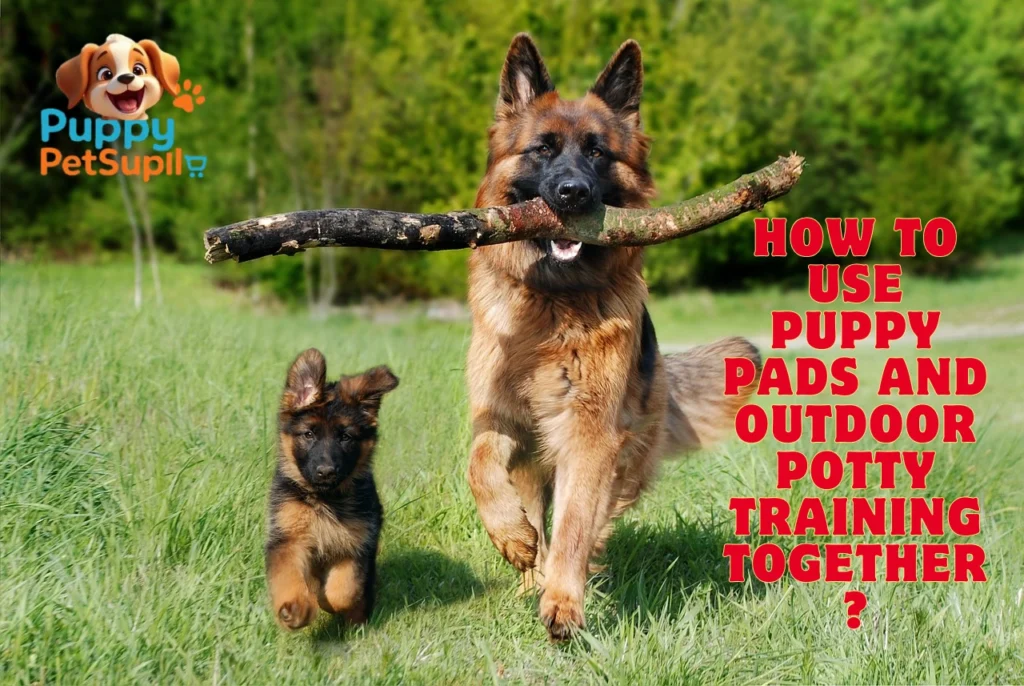How to Use Puppy Pads and Outdoor Potty Training Together?
Did you know that house soiling is a big reason dogs lose their homes or end up in shelters? Effective potty training is key for a happy life with your pet.
It’s important to know when and where to potty train your puppy. Using puppy pads with outdoor potty training helps your puppy adjust to different places.
How to use puppy pads and outdoor potty training together
Key Takeaways
- Combining puppy pads and outdoor training for effective potty training
- Understanding the importance of potty training for a happy, healthy puppy
- Tips for adapting potty training to different environments
- Best practices for using puppy pads indoors
- Benefits of a combined potty training approach
Understanding the Benefits of Dual Potty Training Methods
Using both indoor and outdoor potty training can change the game for puppy owners. It offers a flexible and effective way to housebreak. This method works well for different living situations and puppy needs.

A well-lit, detailed scene depicting two parallel potty training methods for puppies. In the foreground, a puppy standing on a puppy pad, with a bowl of treats nearby. In the middle ground, another puppy exploring an outdoor grassy area, with a leash attached. The background features a clean, modern bathroom setting with natural lighting filtering in, creating a calming atmosphere. The scene conveys the complementary nature of these two potty training approaches, encouraging the viewer to consider the benefits of using them together.
Why Combining Indoor and Outdoor Training Works
Dr. Burch says using puppy pads and outdoor training together is beneficial. “You’re reinforcing two different options for the puppy,” she explains. This approach helps puppies learn to go in specific areas, indoors and outdoors.
The key advantage of this method is its flexibility. For example, during bad weather or when the puppy is too young, indoor training is a good backup.
Advantages for Different Living Situations
The dual potty training method is great for apartment dwellers or those in areas with extreme weather. It’s a practical solution when outdoor training isn’t possible. Outdoor training is key for puppies that spend time outside, teaching them to go in the right spots.
| Living Situation | Benefits of Dual Potty Training |
| Apartment Living | Convenient indoor potty training for times when outdoor access is limited |
| Harsh Weather Conditions | Allows for indoor potty training during extreme weather, ensuring puppy’s comfort and safety |
| Rural or Suburban Areas | Enables puppies to learn both indoor and outdoor potty routines, adapting to different environments |
Setting Realistic Expectations Based on Breed and Age
When starting dual potty training, it’s important to set realistic goals. Different breeds learn at different rates, and age affects a puppy’s bladder and bowel control.
Knowing these factors helps us tailor training to the puppy’s needs. This makes housebreaking more effective.
Essential Supplies and Preparation for Dual Potty Training
To train your puppy with both pads and outdoor potty, you need the right supplies and a routine. This method makes housetraining easier and less stressful for you and your puppy.
Selecting the Right Puppy Pads and Holders
Choosing the right puppy pads is key for indoor training. Look for pads that soak up well, have a leak-proof layer, and fit your puppy. Options include disposable and washable pads. You’ll also need a holder to keep the pads in place.
Use a puppy pad holder or tray to keep the pads from moving. This keeps the area clean and helps your puppy find the potty spot easily.
Creating Designated Indoor and Outdoor Potty Areas
It’s important to have specific potty areas indoors and outdoors. Choose an indoor spot that’s easy to get to and near where your puppy eats and sleeps. For outdoor training, pick a safe, convenient spot close to your door.

A cozy corner in a modern home, bathed in warm, natural light from a large window. In the foreground, a playful puppy sits on a soft, plush puppy pad, chewing on a durable chew toy. The puppy’s curious eyes and alert stance suggest it is in the midst of potty training. Nearby, an assortment of essential supplies is neatly arranged, including a training guide, treats, and a spray bottle for cleaning. The middle ground features a neutral-toned, minimalist room design, with clean lines and a calming color palette. In the background, a glimpse of a well-tended outdoor space can be seen, hinting at the dual potty training approach.
Preparing Cleaning Supplies and Rewards
Accidents will happen, so have pet-safe cleaners ready. Use them to remove stains and odors. Reward your puppy with treats, praise, and affection when they use the potty correctly.
Developing a Consistent Schedule
A consistent schedule is vital for potty training. Puppies can’t hold their urine for long. Take your puppy to the potty area at the same times each day, like after meals and naps.
| Time of Day | Potty Break Activity |
| First thing in the morning | Take puppy to outdoor potty area |
| After breakfast | Take puppy to outdoor potty area |
| After playtime | Take puppy to designated potty area (indoor or outdoor) |
| Before bedtime | Take puppy to outdoor potty area |
By sticking to this schedule, you’ll help your puppy learn when and where to go potty. This makes training smoother and more effective.
How to Use Puppy Pads and Outdoor Potty Training Together
Using puppy pads indoors and outdoor potty training together needs a smart plan. This mix helps fit different homes and puppy needs. It makes potty training flexible and effective.
Teaching Your Puppy to Use Pads Indoors
First, put your puppy on the pad when they seem to need to go. Say a cue word like “Go potty” each time. This helps them learn to go on the pad and where it is. Consistency is key in this step.
When your puppy gets used to the pads, use them only when needed. This could be during bad weather or when you’re away.
Introducing Outdoor Potty Routines
After your puppy gets the hang of indoor pads, start outdoor potty training. Take them to the same spot each time. Use the same cue word or phrase you used indoors.
Positive reinforcement is key; praise and treat your puppy when they go potty outside.
Using Consistent Commands and Reward Systems
Being consistent with commands and rewards helps your puppy understand. Use the same commands for both indoor and outdoor training. Always reward good behavior. This makes training smoother and less confusing.
Monitoring and Tracking Progress
Watching your puppy’s progress is important for adjusting your training. Keep a log or use a tracking app to note when they go potty. This helps spot patterns and areas to improve.
By staying proactive and adjusting based on your puppy’s progress, you can have a successful potty training journey.
Troubleshooting Common Dual Training Challenges
Dealing with common challenges is key to successful dual potty training. This method uses puppy pads indoors and outdoor potty training. It needs patience, consistency, and quick problem-solving.
Addressing Confusion Between Indoor and Outdoor Potty Areas
Puppies often get confused between indoor and outdoor potty spots. This can lead to accidents. To fix this, make sure the indoor and outdoor areas are different. Use different surfaces or layouts to help your puppy understand.
Being consistent is important. Stick to your training schedule and reward your puppy for using the right spot. Over time, your puppy will learn where to go.
Handling Regression and Accidents Properly
Regression and accidents are part of training. It’s important to handle them right to avoid setbacks. If your puppy has an accident, clean up the area well. This removes scents that might attract your puppy again.
Dr. Burch says, “A dog who seems hard to housetrain should see a vet before several months.” Sometimes, house soiling can mean a physical problem.
Adjusting Training for Different Seasons and Weather
Weather and seasons can affect dual potty training. In bad weather, your puppy might not want to go outside. Have a backup plan, like a covered area or indoor potty, to keep training going.
Special Considerations for Apartment Living
Dual potty training is great for apartment dwellers. But, it needs special care. Choose a puppy pad for indoor use and place it in a spot your puppy can easily find.
Here’s a quick guide to solving dual potty training challenges:
| Challenge | Solution |
| Confusion between indoor and outdoor potty areas | Make indoor and outdoor areas distinct |
| Regression and accidents | Clean up accidents thoroughly, check for health issues |
| Weather and seasonal changes | Have a backup plan for extreme weather |
| Apartment living | Choose appropriate puppy pads and designate an indoor area |
Conclusion
Using both puppy pads and outdoor training is a smart way to potty train. It’s flexible and works well. This method helps our puppies learn to go potty in different places, making training easier.
Training a puppy to use the bathroom indoors and outdoors needs patience and consistency. Positive reinforcement is key. Using consistent commands and rewards helps a lot. We also need to create special potty areas and watch how they do.
Outdoor potty training is a big part of this method. We introduce outdoor potty routines and adjust for weather. This helps our puppies adjust and learn to go potty outside and inside. With the right effort, most dogs can do this, making our lives better and our bond with them stronger.
FAQ
Puppy pads and outdoor potty training help puppies learn to go potty in different places. This makes it easier for them to adapt to various situations. It’s very helpful for puppies living in apartments or areas with harsh weather.
To teach your puppy to use puppy pads indoors, first pick the right pads and holders. Create a special potty area and stick to a schedule. Always reward your puppy when they use the pads correctly.
Start introducing outdoor potty routines slowly. Use the same commands and rewards to teach good behavior. Take your puppy to the outdoor potty area right after meals and playtime.
Dual potty training can be tricky, with challenges like confusion and accidents. Stay patient, consistent, and positive. Adjust your training as needed to meet your puppy’s needs.
Adjust your training for different seasons and weather by considering your puppy’s needs. For harsh weather, use more puppy pads indoors. Be flexible and adapt your training as needed.
Yes, apartment living requires special considerations for dual potty training. Use puppy pads indoors and have a specific outdoor potty area. Be mindful of your puppy’s needs and adjust your training as needed.
Keep a record of your puppy’s potty breaks, including time, location, and accidents. This helps you see where to improve and adjust your training.
The best practices include being consistent, patient, and positive. Establish a routine, use the right supplies, and adjust your training as needed for your puppy’s needs.

